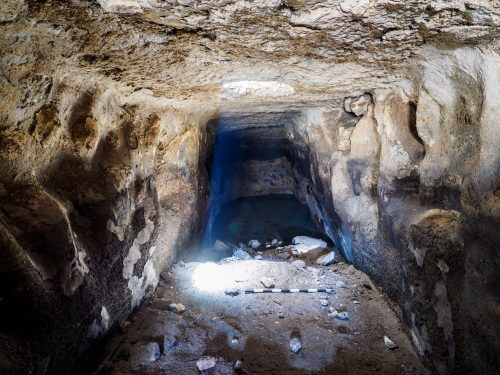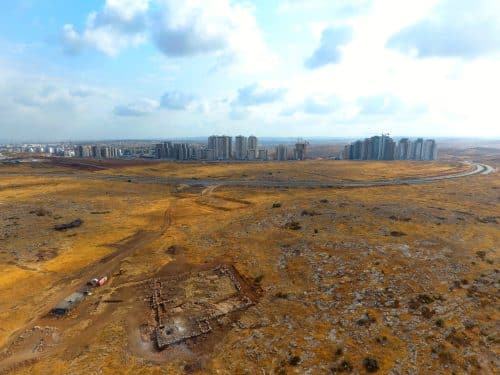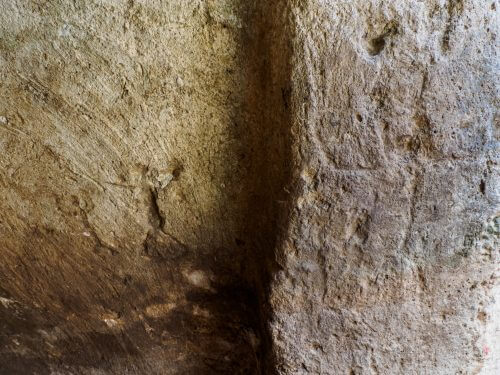The students of the Land of Israel and Archeology major took part in the excavations; The director of the excavation: "It seems that this is an administrative site, which was built in the Assyrian times and controlled the farm houses around it." The Antiquities Authority, in cooperation with the Ministry of Construction and Housing and the Rosh Ha'Ain Municipality, designates the site to be used as a public area open to the public's welfare, near the residential neighborhood that will be built on the site

An impressive 2700-year-old water plant was recently uncovered in an archaeological dig by the Antiquities Authority near Rosh Ha'Ein, with the participation of students from the Ministry of Education's Israel and Archeology major. The excavation is being conducted before the establishment of a residential neighborhood at the initiative of the Ministry of Construction and Housing.
According to Gilad Yattah, the director of the excavation on behalf of the Antiquities Authority, "It is difficult not to be impressed by the appearance of the large underground space, which was excavated so many years ago. In ancient times, rainwater storage was a very basic need. About 500 millimeters of rain fall in the area, and it seems that the winter rains filled the reservoir easily. On the sides of the reservoir, near the entrance, we identified engravings of human figures, crosses and plant decoration which were probably engraved in a later period by passers-by. In total, we identified seven figures, whose size is 15-30 cm. Most of their hands are raised in the air, and it seems that some of them are holding some kind of object."
The length of the exposed water plant is almost 20 m, and it rises to a height of more than 4 m. From the excavations it appears that the reservoir was built in the area of a large structure, the length of each of its walls was almost 50 m. Fragments of pottery were found on the floors of the rooms, some of which must have been used to draw water from the reservoir. It seems that the building and the water reservoir were founded at the end of the Iron Age (the end of the 8th century or the beginning of the 7th century BC), but while the building was abandoned during the Persian period, the water reservoir was active until today.

In recent years, excavations in the Rosh Ha'Ein area revealed a number of farmhouses that were also built at the end of the First Temple period. It seems that these buildings were erected after the destruction of the Kingdom of Israel in 720 BC, when the Assyrian Empire took over the area. The establishment of the farm houses in this area is interesting, in light of the fact that many areas within the territories of the ruined Kingdom of Israel remained desolate. Some researchers believe that the establishment of the farms responded to the imperial interest in settling the area, which was near the international road and near the western border of the Assyrian Empire. According to Yattah, "the structure that was uncovered in the excavation now, is different from most of the farm houses that were uncovered in the past. According to its orderly plan, its spacious area, its strong walls and the impressive water reservoir that was carved out of it, it is possible that this is a site of an administrative nature, perhaps one that controlled the farm houses around it."
The students of the Land of Israel Studies and Archeology major participated in the archaeological excavations in Rosh Ha'Ain as part of the new training course of the Antiquities Authority and the Ministry of Education, which seeks to connect the past and train the archaeologists of tomorrow. Students who choose this track as part of the alternative assessment for matriculation, participate in an excavation week. They experience the variety of roles involved in excavation, discuss the research questions and the archaeological considerations, and record the excavations in an 'excavation journal' as part of the research work.
The Antiquities Authority, in cooperation with the Ministry of Construction and Housing and the Rosh Ha'Ein Municipality, intend to turn the site into a public area open to the public, near the residential neighborhood that will be built on the site.


One response
The question that is always asked is
Is there any finding that indicates a Jewish or Israeli people who lived here before the time of King David.
Or the whole story of the exodus from Egypt and the conquest of the land by Joshua, was invented during the time of King David as claimed by certain archaeologists.